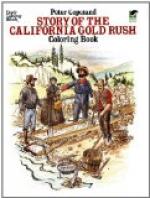So rich were some of the sand bars along the American and Feather rivers that the first miners made a thousand dollars a day even by this careless way of washing gold where much of it was lost. Then again for days or weeks the miner found nothing at all. He would wander up and down the canons and gulches, prospecting for another claim, and dreaming day and night of finding a stream with golden sands, or of picking up rich nuggets. If he found good “diggings” he would build a rough shanty under the pines, and dig and wash till the gold-bearing sand or gravel gave out again. Sometimes he had a partner and a donkey, or burro, to carry tools and pack supplies. More often the Argonaut cooked his own bacon and slapjacks and simmered his beans over a lonely camp-fire, and slept wrapped in a blanket under the trees. If he had much gold, he would go to the nearest town, buy food enough for another prospecting tramp, and often spend all the rest of his money in foolish waste.
Sometimes a company of miners would build a dam across a river or stream, and turn it from its course, so they could dig out and wash the rich gravel in the river-bed. A flume, or ditch, would often carry all the water to a lower part of the river, leaving the bed of the upper stream dry for miles. In this kind of mining the “pay-dirt” was shovelled into long wooden boxes called sluices, and a constant stream of water kept the gravel and earth moving on out to a dumping-place. The gold dropped down or settled into riffles, or spaces between bars placed across the bottom of the sluices, and once a week the water was turned off and a “clean-up” made of the gold.
It was not long before the rivers, creeks, and gulches had all been worked over and most of the gold taken out. The miners knew that this loose gold had been washed out of the hills by the rains and storms of countless years. So some one thought of using a heavy stream of water to break down the foot-hills themselves and to carry the gold-bearing gravel to sluice boxes. This is called hydraulic mining and is the cheapest way of handling earth, as water does all the work and very little shovelling is needed. But since a strong water-power is necessary, a large reservoir and miles of ditches or wooden flumes must be built, so the first expense is large. The water usually comes from higher up in the mountains, and is forced under great pressure through iron pipes, the nozzle or “giant” being directed at the hillside, which has already been shattered by heavy blasts of powder. The water tears thousands of tons of earth and gravel apart, and the muddy stream flows through sluices, where the gold is left. In this kind of mining a great quantity of debris, or “tailings,” must be disposed of.




